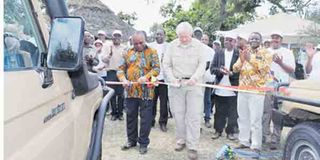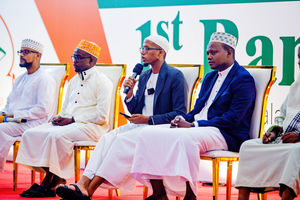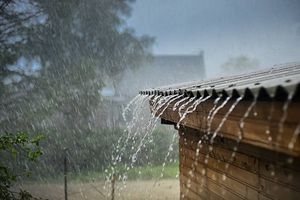Selous animal rescue plan launched

Natural Resources and Tourism minister Prof Jumanne Maghembe (left) and Germany ambassador to Tanzania Egon Kochanke cut a ribbon during the handing over of six vehicles at Matambwe Gate near Lake Tagalala in the Selous Game Reserve recently.PHOTO| COURTESY
What you need to know:
- In 2014, the United Nations organnisation for Education, Science and Culture (Unesco) listed Selous in the list of the World Heritage Site (WHS), which are in danger of diminishing. This was due to increased poaching incidents.
- A 1976 survey showed that the SGR had a population of 106,300 elephants, 2,135 black rhinos, 18,200 hippopotamuses, 204,015 buffaloes, 7,000 sable antelopes, 52,150 Lichtenstein’s hartebeests and 80,815 Nyassa wildebeests.
Dar es Salaam. Implementation of the Emergency Action Plan (EAP) in the Selous Game Reserve aimed at removing the animal kingdom from the list of endangered game reserves has started. The government is working with conservation stakeholders in the implementation of the plan also dubbed Selous Ecosystem and Development (Secad).
In 2014, the United Nations organnisation for Education, Science and Culture (Unesco) listed Selous in the list of the World Heritage Site (WHS), which are in danger of diminishing. This was due to increased poaching incidents.
A 1976 survey showed that the SGR had a population of 106,300 elephants, 2,135 black rhinos, 18,200 hippopotamuses, 204,015 buffaloes, 7,000 sable antelopes, 52,150 Lichtenstein’s hartebeests and 80,815 Nyassa wildebeests.
It is because of such Outstanding Universal Value (OUV) in terms of vast wilderness, ecological and biological processes and the high density and diversity of fauna and flora that Unesco inscribed SGR the WHS status in 1982. However, the elephant population was decimated to 55,000 in 1985, down to 22,000 in 1991 before the trend was reversed to 70,000.
The 2013 survey came with shocking findings as the elephants population had drastically declined to an alarming figure of 13,000, the lowest ever recorded.
Speaking during the event at Matambwe Gate near Lake Tagalala within the SGR, Prof Jumanne Maghembe, who is the Natural Resources and Tourism minister, said since 2014 when SGR was pronounced the WHS in danger, the government has been collaborating with stakeholders, development partners and conservationists to address challenges that prompted Unesco to make the decision.
He said such efforts led to the formulation of the EAP and the Secad through which the Germany government through the German Development Bank (KfW) has provided euro 18 million (Sh40 billion) in support of the projects and that collectively, Frankfurt Zoological Society (FZS) and the World Wildlife Fund (WWF) were committed to contribute euros 400,000 (Sh1 billion) each. “The EAP and Secad programmes launched today have been possible due to stakeholder’s support. However, considering the sheer size and the emerging challenges, a gap still remains in terms of financial resources that call for other conservation partners to support implementation of unfunded activities,” he said.
He said the Secad programme would help in capacity building during the anti-poaching war by providing game rangers with enough equipment. He commended the Germany government for donating six cars which he said will play an important role in fighting poachers in the game reserve. “Last year, I received 24 cars, this year our Germany counterparts have provided us with six brand new Landcruisers. I expect to receive 15 more vehicles from the government in the next few weeks. These will strengthen our means of transportation during the ongoing anti-poaching war,” he said.
Prof Maghembe said the government has plans to invest Sh156 billion in infrastructure development in the Selous, Ruaha, Mikumi and Kitulo in its efforts to increase the number of tourists in the southern circuit.
He said higher flight charges to tourists visiting Selous will soon be avoided through use of Air Tanzania Company Limited (ATCL) planes.
“Charter flights have been charging tourists $800 (Sh1.75 million) being fare from Dar es Salaam to Iringa. Since ATCL flies from Dar es Salaam to Songwe, we are finalising talks so that two flights would pass by Iringa in a bid to promote our tourism. That they should fly from Dar es Salaam to Nduli before landing to Songwe and then Dar es Salaam,” he said. “In the second route, ATCL flights will be from Dar es Salaam to Kigoma through Mpanda and Katavi before returning to Dar es Salaam. The area is well developed with modern hotels having been constructed to make the destination more attractive to tourists.”
Welcoming Prof Maghembe, the permanent secretary of the ministry, Mej Gen Gaudance Millanzi, said the launched EAP and Secad demonstrated that in collaboration with the international community the government was committed to combating poaching in the area which prompted for being inscribed the WHS in danger. “Other efforts include establishment of the Tanzania Wildlife Management Authority (Tawa), formulation of the National Anti-Poaching Strategy, establishment of the Wildlife Basket Fund (WBF) for supporting anti-poaching initiatives and mobilising human, material and financial resources,” he said.
Tawa board of director and chairman Maj Gen Hamis Semfuko said Tawa was committed to conserving OUV within the SGR, promising to work hard to ensure mobilised resources were properly used to address intended objectives in increasing the ability of the youth in protecting the country’s national resources.
“This job requires the highest degree of patriotism and enough resources. By donating six vehicles and euros 18 million, Germany has provided us with the required empowerment. We need to provide enough training to game wardens in so as to build their capacity to pro actively protect our natural resources,” he said.
Germany ambassador to Tanzania, Mr Egon Kochanke, expressed concerns that the escalated poaching that drastically reduced the number of elephants and black rhino in the SGR should be addressed with great vigour to remove the country from a list of WHS in danger which would be a huge achievement to the country’s present and future generations. “The government should reconsider implementation of several projects within the SGR such as hydroelectric power production at the Stiegler’s Gorge, Uranium extraction at Mkuju and the Kidunda Dam water production as they will negatively impact the SGR ecosystem,” he said.
He was supported by WWF Tanzania’s country director, Dr Amani Ngusaru, who said his organisation was conducting environmental assessment impact comprising of stock taking and quantification to establish and propose to the government the right approach to be followed in implementing such projects.
“The government needs an in depth consideration on the projects. We believe the country could realise its economic development through SGR if the infrastructure was properly developed. We will establish and advise to put more investment between photographic and hunting tourism,” he said.
Responding to such concerns, Prof Maghembe reiterated the government’s decision to implement the projects, saying they bare social and economic benefits to the country and its people.
“We will undertake the Uranium project because we need the money to improve our education and infrastructure development, even Unesco are aware of that. Dar es Salaam population is projected to eight million in the next few years, water from Kidunda Dam will compliment shortages we register with Ruvu plants,” he said, adding. “Tanzania has targeted to become an industrial economy which is difficult without reliable electricity, therefore implementation of the hydroelectric power at the Stiegler’s Gorge is inevitable.”
EAP is intended to significantly reduce poaching and recover population of key wildlife species within SGR, the wildlife corridors of Selous-Niassa and Selous-Udzungwa and the Gonabis wildlie dispersal. The plan will be implemented through five specific objectives.
The five specific objectives are strengthened law enforcement and surveillance within SGR, strengthening law enforcement and surveillance in the wider Selous Ecosystem and important corridor/dispersal areas, enhancing management capacity of SGR, secure broader public support for the conservation of SGR and monitoring recovery of the OUV.
The budget shows that $21.49 million equivalent to Sh47.28 billion was required to implement the plan in two years and that $6.98 million equal to Sh15.35 billion was collected to fund implementation of the plan during the 2016/17 Fiscal Year.




